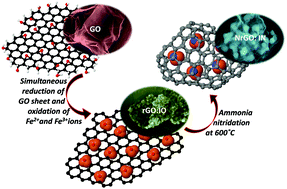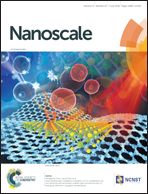Enhanced shielding effectiveness in nanohybrids of graphene derivatives with Fe3O4 and ε-Fe3N in the X-band microwave region†
Abstract
Novel nanocomposites of reduced graphene oxide (rGO)–Fe3O4, denoted as ‘rGO:IO, and nitrogen doped rGO–ε-Fe3N, denoted as ‘NrGO:IN’, were prepared by a modified polyol method, wherein both the reduction of graphene oxide and oxidation of Fe2+/Fe3+ ions occurred simultaneously, followed by ammonia nitridation. The electron microscopy analysis of the rGO:IO and NrGO:IN nanocomposites revealed unique morphologies. In rGO:IO, the Fe3O4 nanoparticles having a mean diameter of 38 nm were found to be uniformly anchored to the rGO sheet surface, whereas in NrGO:IN, the ε-Fe3N nanoparticles (∼150 nm) were shielded by the NrGO sheets. Superparamagnetic and weak ferromagnetic characteristics with saturation magnetization values of 39.5 and 46 emu g−1 were observed in the rGO:IO and NrGO:IN nanocomposites respectively, which can be attributed to the nature of the constituent magnetic nanoparticles, Fe3O4 and ε-Fe3N. In addition, the graphene derivatives such as rGO and NrGO contributed to the enhanced electrical properties of the nanocomposite. The electrochemical impedance spectroscopy analysis showed that, compared to pure Fe3O4 and ε-Fe3N nanoparticles, the total electrical resistance of rGO:IO and NrGO:IN was reduced by 33 344.8 and 1569.87 Ω cm−2, respectively, when combined with the rGO and NrGO sheets. Further, the electromagnetic shielding performance of the NrGO:IN nanocomposite was investigated for the first time and was compared with the other samples. Of the two prepared nanocomposites, NrGO:IN exhibited electromagnetic shielding effectiveness of 35.33 dB at 11.4 GHz, which is considerably larger than that of rGO:IO (14.4 dB at 8 GHz). This enhanced shielding effectiveness is not only due to the high inherent magnetic and electrical properties of ε-Fe3N nanoparticles, but also due to the ‘particle shielded by sheet’ morphology of the NrGO:IN, which enhances the charge accumulation at the heterogeneous interfaces of NrGO sheets/ε-Fe3N nanoparticles.



 Please wait while we load your content...
Please wait while we load your content...